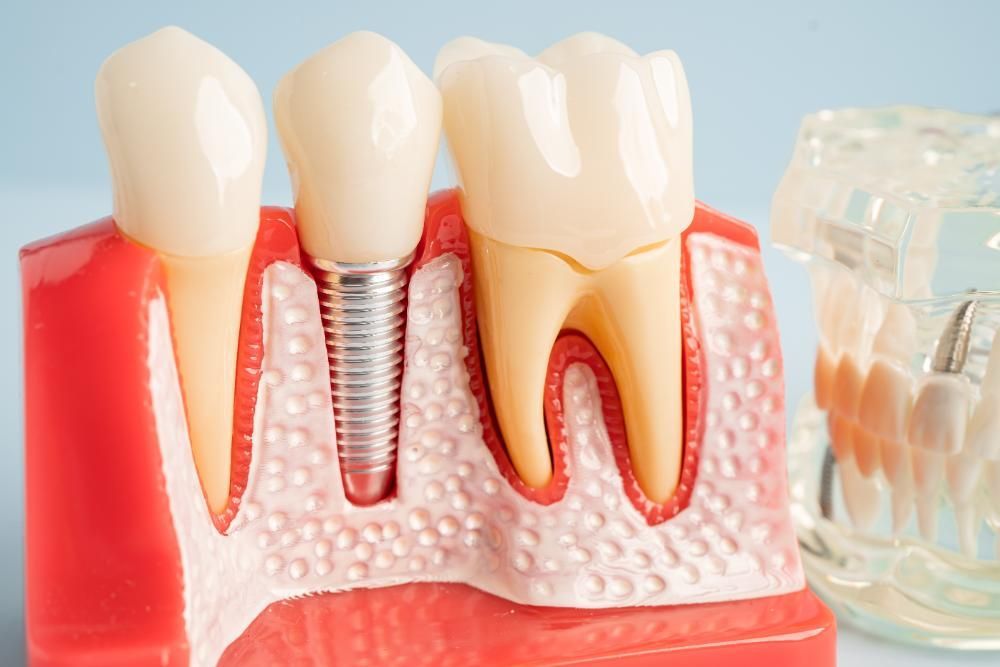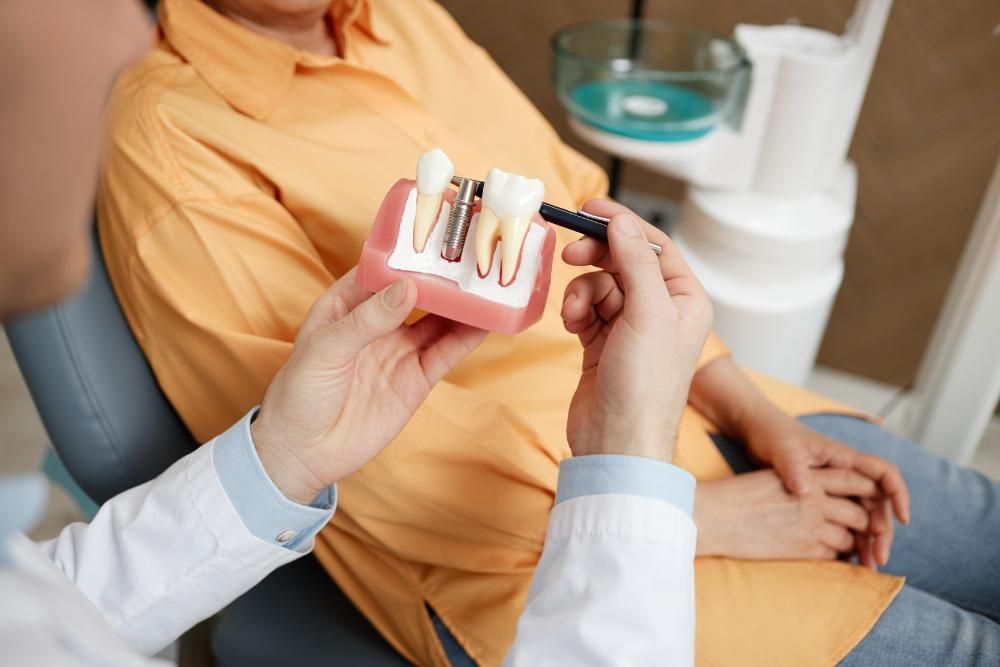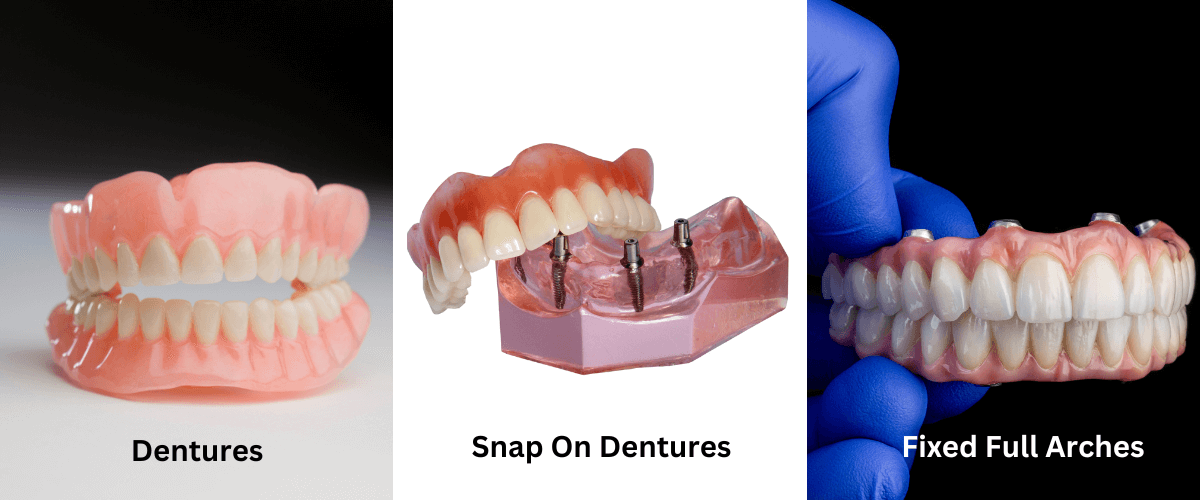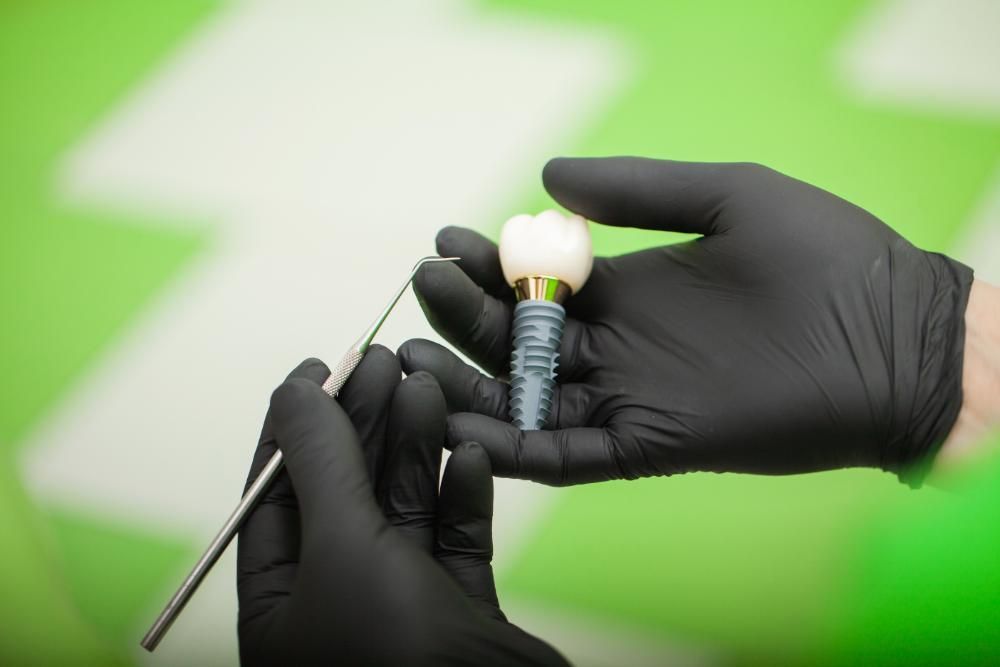Contact Information
smiles@mylakesidedentist.com
15400 19 Mile Rd, Clinton Twp, MI 48038, United States of America
Serving Clinton Township and Surrounding Areas
info@mylakesidedentist.com
(586) 228-0909
The Complete Guide to Implant in Dentistry: Types, Procedures, and Benefits
16 Minute Read
An implant in dentistry is a solution for replacing missing teeth with artificial roots inserted into the jawbone. These implants support fixed or removable replacement teeth that function like natural ones. This guide covers everything you need to know: types of implants, the dental implant procedure, recovery, and benefits.
Key Takeaways
- Dental implants are categorized mainly into endosteal and subperiosteal types, providing secure and durable tooth replacements that preserve natural tooth structure.
- The dental implant procedure involves multiple steps, including initial consultation, possible bone grafting, implant placement, and attaching the final crown, ensuring a successful integration into the jawbone.
- Benefits of dental implants include improved chewing and speaking functionality, prevention of jawbone loss, enhanced self-confidence, and a long-term cost-effectiveness compared to dentures and bridges.
The Complete Guide to Implant in Dentistry: Types, Procedures, and Benefits

Dental implants are artificial teeth structures inserted into the jawbone, serving as a replacement for missing teeth. Falling under the categories of prosthetic and cosmetic dentistry, dental implants support restorations for missing teeth, providing a durable and natural-looking solution. The most common type of dental implant is the endosteal implant, which is inserted directly into the jawbone, making it a key component of implant dentistry.
Mini dental implants can stabilize lower dentures when there is insufficient jawbone. On the other hand, subperiosteal implants are placed under the gum but above the jawbone, making them suitable for those lacking adequate jawbone height. Dental implants replicate the comfort and functionality of natural teeth more effectively than dentures or bridges and can significantly increase a patient’s self-confidence.
One of the most remarkable benefits of dental implants is their ability to prevent jawbone loss by replacing missing tooth roots, which stimulates and maintains the jawbone. Unlike traditional bridges, dental implants do not require altering healthy adjacent teeth, preserving more of your natural tooth structure. With proper care, dental implants are the most durable option for tooth replacement, often lasting a lifetime.
Imagine the freedom of eating your favorite foods without worry, speaking clearly, and smiling confidently. Dental implants can offer this freedom because they function like natural teeth. They are not just the only dental restoration option that mimics the natural tooth root; they also provide a foundation that allows for the replacement of one or more teeth without affecting neighboring teeth.
This guide covers the various dental implant types, the procedure, recovery, and aftercare. It also delves into the benefits, potential complications, costs, and maintenance tips. Whether you’re considering implants for yourself or a loved one, you’ll find all the necessary information here.
Introduction
Tooth loss can negatively affect eating habits, potentially leading to malnutrition. Replacing missing teeth with dental implants enhances oral health and improves overall well-being.
Learn about the transformative impact dental implants can have on your life through this guide.
Understanding Dental Implants

Inserted into the jawbone, dental implants support restorations for missing teeth. The endosteal implant, the most common type, is placed directly into the jawbone and resembles small screws or blades. Narrower mini dental implants can stabilize lower dentures.
Subperiosteal implants are designed for individuals lacking adequate jawbone height and are placed under the gum but above the jawbone. Most dental implants are recognized as the most durable option for tooth replacement, often lasting a lifetime with proper care. They replicate the comfort and functionality of natural teeth more effectively than dentures or bridges.
Dental implants preserve natural tooth structure by not requiring alterations to adjacent healthy teeth. They closely resemble natural teeth, often boosting self-confidence. The osseointegration process, where the jawbone fuses with the implant, ensures stability and functionality.
Types of Dental Implants

Dental implants can be classified into three main types. These are endosteal, subperiosteal, and zygomatic implants. The most prevalent types are endosteal and subperiosteal, differing in how they connect to the jawbone.
Knowing these types will help you choose the best option for your needs.
Endosteal Implants
Endosteal implants, the most common type, are designed like small screws, cylinders, or blades and are inserted into the jawbone to support prosthetic teeth. Typically screw-shaped, they provide a sturdy foundation for replacement teeth.
Because they integrate directly with the jawbone, endosteal implants are often the preferred choice for patients with adequate bone density. They offer a secure and durable solution, enhancing both functionality and aesthetics.
Subperiosteal Implants
Subperiosteal implants, positioned on or above the jawbone, consist of a metal post that protrudes through the gum. Designed for patients with insufficient jawbone height, they provide an alternative to traditional implants by resting on top of the jawbone but beneath the gum.
The metal post emerging through the gum secures the prosthetic teeth, offering a stable and functional replacement. This type of implant is often used when bone grafting is not a feasible option.
Zygomatic Implants
Zygomatic implants are less common and are anchored in the cheekbone rather than the upper jaw, typically used when there is insufficient bone in the upper jaw. These implants are considered when patients lack adequate upper jaw bone for traditional implants. Anchored in the cheekbone, zygomatic implants provide a robust alternative for those with significant bone loss in the upper jaw.
This approach eliminates the need for bone grafting and offers a viable solution for patients who otherwise might not be candidates for dental implants.
The Dental Implant Procedure

The dental implant procedure comprises several critical steps, from the initial consultation to the final crown placement. Each phase ensures the success and longevity of the implants.
Initial Consultation
The initial consultation includes a thorough dental examination and imaging like X-rays to assess the patient’s situation. Patients should disclose their complete medical history, including medications, to evaluate any potential risks.
Options for local anesthesia and sedation dentistry are discussed to ensure patient comfort during the procedure. Estimated costs for dental implants and factors influencing variation are provided, allowing patients to plan their finances accordingly.
This detailed consultation lays the groundwork for a successful dental implant procedure.
Bone Grafting
Bone grafting is often required if the jawbone lacks sufficient density to securely hold an implant. Natural or synthetic materials can be used for bone grafting to rebuild the jawbone before implant placement.
Healing time for bone grafts varies but typically takes several months before implant placement. This step ensures the jawbone can support the implant, providing a strong foundation for the new tooth.
Placing the Implant
Dental implantation is performed after adolescence when bone growth is complete. A pilot hole guides the surgical placement of the titanium implant fixture deep into the jawbone.
If the implant is near the front, a temporary tooth is provided until healing, but it may not be needed for back implants. Dental implants typically consist of a titanium screw serving as an artificial tooth root and a crown for the visible tooth structure.
Osseointegration Process
Osseointegration, the bone healing process, involves the jawbone integrating with the implant. This phase is crucial for the implant’s stability and functionality, as bone growth secures the implant firmly in place.
Attaching the Abutment
Attaching the abutment, which connects the implant to the crown, may require a minor surgical procedure after the healing period. This component ensures a secure connection between the implant and the restoration.
Fitting the Crown
Impressions of the mouth are taken to create a custom crown, which can be fixed or removable. After healing, the abutment and final restoration, which can be a crown, bridge, or denture, are attached to the implant.
Recovery and Aftercare
Pain medications should be taken as soon as post-operative discomfort arises. Adhering to post-procedure instructions is crucial for healing and successful integration of dental implants. Rest and avoid strenuous activities for at least three days post-surgery.
Swelling is a common response that peaks within 2 to 3 days after the procedure. Soft foods like yogurt and smoothies should be consumed for the first few hours post-surgery. Avoid using straws, smoking, and consuming hot drinks for several days to prevent complications. Rinse with warm saltwater starting 24 to 48 hours after surgery to aid healing.
Sutures typically remain for about two to three weeks. Follow-up appointments with treatment coordinators are essential for monitoring progress after surgery.
Benefits of Dental Implants

Dental implants improve chewing and speaking functionality compared to other tooth replacement methods. They significantly enhance biting and chewing abilities, restoring up to 80 percent of natural function. Unlike dentures, implants allow a wider variety of foods, promoting better nutrition.
Dental implants are more durable than traditional tooth replacement options like dentures or bridges. Though the upfront cost is higher, their long-term cost-effectiveness can surpass that of dentures or bridges due to less frequent replacements. By filling gaps, implants help maintain the alignment of surrounding natural teeth.
Implants prevent jawbone deterioration, preserving facial structure and preventing sagging and wrinkles. These benefits make dental implants a superior choice for long-term oral health and aesthetic improvements.
Potential Complications and Risks
Infections can arise at the site of a dental implant, leading to symptoms like:
- pain
- swelling
- redness
- pus
Dental implants in the upper jaw may extend into the sinus cavity, potentially causing sinus infections.
Implant failure occurs when the dental implant does not properly integrate with the jawbone or becomes loose.
Post-implant complications can include loosening of the implant, peri-implantitis, or fractures due to trauma or overloading. Nerve or tissue damage during the placement of an implant can result in discomfort, numbness, or tingling sensations.
Allergic reactions to materials used in implants, like titanium, can occur, with symptoms ranging from itching to severe reactions. Monitoring for symptoms like swelling or pain is crucial for detecting complications related to dental implants early.
Cost Considerations
The overall expense of dental implants includes various stages, from the initial consultation to surgical placement and follow-up care. Several factors influence dental implant costs, including the number of implants, material type, additional procedures, location, and the dentist’s experience. Opting for quality materials and a skilled dentist may lead to higher initial costs but ensures long-term satisfaction and success.
Financing options for dental implants may involve healthcare credit cards, personal loans, or payment plans offered by clinics. Insurance coverage for dental implants can vary significantly; some plans may cover a portion while others may exclude them entirely.
Patients should compare costs and negotiate payment plans with dental providers to find the best financial options. Dental discount plans and assistance programs can offer reduced rates for procedures like implants for those without adequate insurance.
Maintaining Your Dental Implants
Consistent oral hygiene is essential for keeping dental implants clean and preventing plaque accumulation. Using low-abrasive toothpaste and waxed dental floss helps protect the surface of dental implants. Regular dental checkups are also important for monitoring implant condition and performing professional cleanings.
Avoiding hard foods, using teeth as tools, and smoking can help prevent damage to dental implants. Wearing a custom mouthguard can protect dental implants from injury during sports or due to teeth grinding.
These practices ensure the longevity and functionality of your dental implants, maintaining your oral health for years to come.
Summary
Dental implants offer a durable, functional, and aesthetically pleasing solution for replacing missing teeth. From the initial consultation to the final fitting of the crown, the dental implant procedure is designed to restore not just your smile, but your ability to eat, speak, and live confidently. With proper care and maintenance, dental implants can last a lifetime, providing a superior alternative to traditional dentures and bridges. Consider dental implants to enhance your oral health and overall quality of life.
Frequently Asked Questions
-
Can a general dentist provide Invisalign treatment?
Yes, general dentists can provide Invisalign treatment after completing a certification course that includes orthodontic foundations and treatment options.
-
How does Invisalign training for dentists work?
Invisalign training for dentists includes on-demand modules, hands-on workshops, and post-course support, such as live coaching sessions and educational opportunities. This helps dentists learn how to use Invisalign effectively.
-
What are the differences between a general dentist and an orthodontist in providing Invisalign treatment?
In conclusion, orthodontists have more extensive training, experience, and access to advanced technology for Invisalign treatment than general dentists.
-
What are the pros and cons of getting Invisalign from a general dentist?
Getting Invisalign from a general dentist can offer a broader range of dental services and may be more cost-effective. However, it's essential to consider the limited expertise in addressing complex alignment issues.
-
How much does Invisalign treatment cost?
Invisalign treatment typically ranges from $3,000 to $8,000, depending on case complexity and treatment duration, regardless of whether you go to a general dentist or an orthodontist.








CONTACT US FOR A FREE CONSULTATION
Ready to Take the Next Step Towards a Full, Vibrant smile?
Start your journey towards exceptional dental care. Our mission is to help you unlock your perfect smile and embrace the essence of quality dentistry at its finest.

Contact Information
Request a Free Consultation
For more information about our services or to schedule an appointment, call us at (586) 228-0909 or complete the form below we’ll get back to you as soon as we can.
Our Services
Quick Links
Contact Information
smiles@mylakesidedentist.com
15400 19 Mile Rd Suite 180
Clinton Township, MI 48038
All Rights Reserved | Lakeside Family & Implant Dentistry





